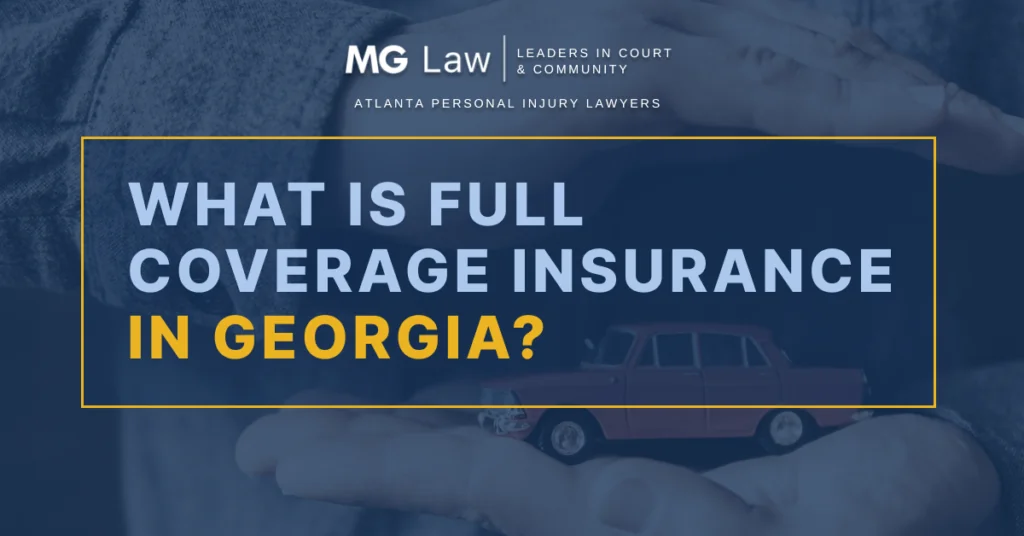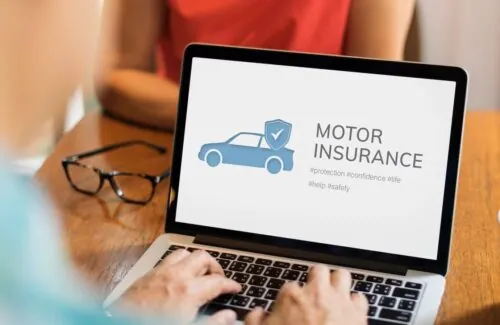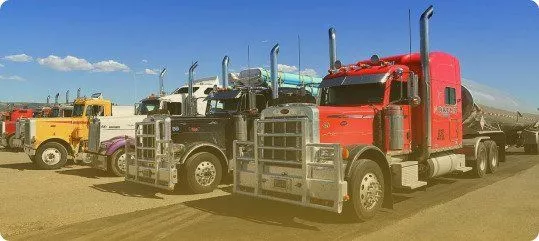
Many people use the term “full coverage,” but what does it mean?
In Georgia, all motorists must carry certain minimum insurance coverage. Full coverage insurance typically includes liability, collision, and comprehensive coverage. It may also include add-ons like roadside assistance and uninsured motorist protection, providing a comprehensive safety net for drivers.
Understanding the range of coverages available can help you tailor a policy that meets your specific needs:
- Liability Coverage: This is essential if you’re at fault in an accident, covering damages and injuries you cause to others, as well as legal fees if you’re sued, up to your policy’s limits.
- Uninsured/Underinsured Motorist Coverage: Protects you if you’re hit by a driver without adequate insurance, covering injuries and damages within specified limits.
- Medical Payments: Covers medical bills and funeral expenses for you and your passengers, regardless of fault. In some states, this may be replaced by personal injury protection.
- Comprehensive Coverage: Offers protection against non-collision-related incidents such as theft, vandalism, fire, or weather damage, covering repair or replacement costs minus any deductible.
- Collision Coverage: Pays to repair or replace your vehicle if it collides with another object, regardless of who is at fault, minus the deductible.
- Gap Insurance: Covers the difference between what you owe on your vehicle loan and the vehicle’s value if it’s totaled.
- Rental Car Reimbursement: Ensures you have a rental vehicle if yours is being repaired after a covered accident.
- Roadside Assistance: Provides services like towing, battery jumps, and flat tire changes if your vehicle is disabled.
By understanding these coverages, you can better customize your auto insurance to fit your driving lifestyle and financial situation, ensuring peace of mind on the road.
How much does full coverage car insurance cost?
Determining the cost of full coverage car insurance involves several key factors. These elements influence your premium and can vary widely from one driver to another.
Key Determinants of Full Coverage Costs
- Vehicle Specifications: The year, make, and model of your car play a major role. Newer or more expensive cars generally incur higher premiums due to the cost of repairs or replacement.
- Coverage Options: Full coverage typically includes liability, comprehensive, and collision insurance. Opting for additional protections like uninsured motorist or personal injury protection (PIP) will increase costs.
- Deductible Amount: Choosing a higher deductible can lower your monthly premium. However, be prepared to pay more out-of-pocket in the event of a claim.
- Driver Profile: Factors such as your age, driving history, and location also affect the cost. Younger drivers or those with past accidents might face higher rates.
making full coverage affordable
Despite the comprehensive nature of full coverage, bundling discounts, safe driving rewards, and maintaining a clean driving record can significantly reduce your costs. Many insurance providers offer various discounts, so it’s worth shopping around and comparing quotes from multiple companies to find the most cost-effective solution tailored to your needs.
Ultimately, while full coverage tends to be pricier than basic liability insurance, the peace of mind and financial protection it offers can be invaluable.
Without this insurance, a driver cannot register their vehicle, and they could face other penalties if they are involved in an accident without proper insurance.
But minimum coverage leaves motorists vulnerable after many wrecks.
There is no agreed definition of what qualifies as “full coverage” insurance in Georgia. But generally full coverage car insurance combines the state’s minimum liability coverage along with collision and comprehensive coverage. But what does this really mean for you as a driver?
When you’re financing or leasing a vehicle, lenders often require what’s termed “full coverage,” which includes not only collision and comprehensive coverage but also any other coverages mandated by your state. It’s important to understand that while liability coverage is mandatory in nearly every state, comprehensive and collision are typically optional unless specified by a lender.
It’s crucial to ask yourself, “Do I have the right coverages?” instead of simply wondering if your policy qualifies as full coverage. Paying for every possible protection can be costly, and bare minimum liability might not provide adequate protection for you and others on your policy.
Consider customizing your policy to fit your needs, your family’s needs, and the specifics of your vehicle. Engage with your insurance company or agent to ensure your coverage aligns with both state requirements and personal circumstances. This strategic approach ensures you’re not only compliant but also well-protected on the road.
There are many reasons to get full coverage, though costs are always a concern.
Our Covington, Georgia auto accident lawyers will explain what you should know. For a free consultation, please don’t hesitate to contact us online or call (770) 988-5252 today.
Jump to a Topic hide Minimum Liability Coverage Uninsured/Underinsured Motorist (UM) Coverage Collision & Comprehensive Coverage Medical Payments Coverage Contact Our Georgia Accident Attorneys Today With Questions
Minimum Liability Coverage

Georgia is a “fault” state when it comes to car accidents and at “fault” when it comes to car accidents. State law requires a minimum limit of liability insurance for bodily injury. This limit is set at $25,000 per person and $50,000 per incident. Under this system, a driver who is at fault for a wreck must pay compensation to those injured. Victims usually suffer two types of damage—bodily injuries and property damage.
Unsurprisingly, Georgia requires that motorists carry a minimum amount of liability insurance. As the name implies, this insurance will kick in when someone covered under the policy causes an accident. So if Driver A strikes Driver B, then Driver B will make a claim on A’s liability insurance policy to pay compensation.
Liability coverage is designed to cover several crucial aspects:
- Damages and Injuries to Others: It pays for the damages or injuries you cause to others if you’re at fault in an accident.
- Lawsuit Costs: If someone sues you, the coverage extends to lawsuit costs, providing a legal safety net.
- Policy Limits: Coverage is provided up to the policy’s limits, ensuring that financial protection is in place within those boundaries.
By understanding these elements, drivers can better appreciate the importance of maintaining adequate liability insurance, not just to comply with legal requirements but to protect themselves from significant financial risk.
Like other states, Georgia sets minimums that those registering a vehicle must have to comply with the law:
- For bodily injury liability, the minimum is $25,000 per person injured up to $50,000 per accident (when 2 or more people suffer bodily injuries). Bodily injury liability pays for medical care, replaces lost wages, and compensates for pain and suffering.
- For property damage, a driver must carry at least $25,000 in insurance. This will pay to repair or replace the victim’s damaged property, such as their car.
Combined, this is called 25/50/25 coverage, as it’s known in the auto insurance industry.
Because these are minimums, a driver could carry more coverage. For example, you might carry $100,000 in bodily injury liability coverage, up to $300,000 per accident. Of course, you will pay more in monthly premiums for more coverage. But if you are at fault for an accident, the victim could sue you personally and, if he wins, try to put a lien on your home or levy a bank account. The cost of medical care continues to skyrocket, so realize that $25,000 might not cover much.
Uninsured/Underinsured Motorist (UM) Coverage
Georgia law requires that any insurer who issues a liability insurance policy must include uninsured/underinsured motorist coverage (O.C.G.A. 33-7-11). They must provide policy limits equal to your liability insurance. So if you get a liability policy with 25/50/25 limits, then an equal amount must be offered of UM coverage.
These policies cover different situations:
- Uninsured motorist coverage. If the at-fault driver lacks insurance, then you can use this coverage.
- Underinsured motorist coverage. The driver might have lower policy limits, and you have unmet expenses. For example, you might carry $100,000 in uninsured motorist coverage, but the at-fault driver has the bare $25,000.
UM coverage is liability insurance, so it only kicks in when you are not to blame for the accident.
Do you need UM coverage? Consider that there are many uninsured drivers in Georgia—according to one estimate, at least 12%. That works out to nearly 1 in 8 Georgia drivers lacking insurance. UM coverage might be the only thing available if an uninsured driver hits you. You can usually make a claim on your UM policy if you are the victim of a hit and run, and the police never find the driver. Underinsured motorist coverage is helpful when you suffer heavy losses and the other driver has policy limits that are too low.
Georgia law allows motorists to reject UM coverage when they pick up the required liability policy. But we want to discourage any motorist from rejecting coverage. Your UM insurance might be the only policy available to pay compensation after many accidents.
Collision & Comprehensive Coverage
To get “full coverage” auto insurance in Georgia, you should get collision and comprehensive coverage.
These policies are different from liability insurance because they are no fault insurance. This means you can be to blame for the wreck or damage to your vehicle, but you can still make a claim to get your car fixed. That makes them greatly beneficial to have.
They are distinct policies:
- Collision. This insurance pays to repair or replace a car that is damaged in a collision. It includes striking another vehicle or running off the road and hitting an object, like a pole or house.
- Comprehensive. This policy will cover the cost to repair or replace a vehicle damaged by something other than a collision. The policy will cover damage from storms, natural disasters, fire, vandalism, theft, and flood.
Let’s say you get into an accident, which is your fault. You cannot make a claim on your liability insurance or the other driver’s liability insurance because you are to blame. However, you could tap your collision coverage to get your car fixed.
Most lenders require that borrowers carry both collision and comprehensive on a car loan. These policies protect the lender’s investment since the car serves as collateral for the loan. If the car were wrecked, it would have little value.
Costs vary for collision and comprehensive. Generally, you could pay several hundred dollars more a month, depending on your driving history and the amount of your deductible. You should contact an insurance agent or request online quotes.
Should you get comprehensive and collision coverage if you don’t have a car loan? It’s really up to you. You might like the added protection just in case you crash. However, make sure this coverage fits your budget.
However, make sure this coverage fits your budget.
Understanding Gap Insurance Coverage
Gap insurance, an all-important safeguard for vehicle owners, covers the financial shortfall between your auto loan balance and the car’s actual cash value if it’s totaled or stolen.
Key Points About Gap Insurance
- Loan Balance Protection: If your vehicle is deemed a total loss, this coverage ensures that you won’t be left paying for a car you no longer drive. It covers the gap between what your insurer pays you based on the car’s market value and what you still owe on your loan.
- Peace of Mind for Leases: If you lease a vehicle, gap insurance is essential. In a scenario where your leased car is wrecked or stolen, this coverage prevents unexpected expenses by covering the lease payout.
- Comprehensive Vehicle Protection: It should be noted that gap insurance is distinct from your standard auto insurance policies, focusing specifically on the depreciation of your vehicle which normal insurance might not fully cover.
In essence, gap insurance acts as a financial buffer, ensuring that an unfortunate event doesn’t turn into an even bigger financial strain. Is it right for you? Consider the rapid depreciation of new cars and your current financial situation to make an informed decision.
Rental Car Reimbursement: A Comprehensive Overview
When you’re dealing with the aftermath of a car accident, the last thing you want to worry about is how to get around while your vehicle is in the shop. That’s where rental car reimbursement steps in to save the day. But what exactly does this coverage include?
What It Covers
- Accident-Related Rentals: If you’re involved in a covered accident and your car is temporarily out of commission, rental car reimbursement will help cover the cost of a rental vehicle. This means you won’t have to halt your daily activities or depend on others for transportation while your car is being repaired.
- Extended Repairs: Sometimes repairs can take longer than anticipated, especially if there are complications or delays in parts. With rental car reimbursement, you’ll have peace of mind knowing your rental costs are covered for the duration specified in your policy.
- Non-Fault Accidents: Whether you’re at fault or not, this coverage can come into play. In many cases, if another driver’s insurance doesn’t cover your rental, your policy will step in as a safety net.
- Coverage Limits: Be aware that there are usually daily limits and a maximum amount allotted for reimbursement. It’s important to understand these limits to manage expectations effectively.
Key Considerations
- Policy Specifics: Always check the specifics of your insurance policy to understand the extent and limits of your rental car reimbursement coverage.
- Rental Company Options: Most policies allow you flexibility in choosing where to rent your vehicle from, including major rental companies like Enterprise, Hertz, or Avis.
By understanding these aspects, you’ll be better prepared to utilize rental car reimbursement effectively when the need arises. Remember, having the right coverage can make a stressful situation just a bit easier to handle.
Medical Payments Coverage
Thus far, we have looked at liability insurance that covers injuries to other people, and comprehensive/collision insurance which pays to repair your vehicle regardless of fault. But what about bodily injuries you suffer when you cause an accident?
This is where medical payments coverage comes in. This insurance will pay for medical treatment for victims regardless of whether you were to blame for the accident. It can also pay for medical care to any of your passengers who were injured.
Medical payments coverage is optional in Georgia, but it is definitely something you should consider if you are trying to get full coverage. Generally, insurers offer at least $2,000 in coverage but policies can go up to $10,000. Of course, your monthly car insurance premium will also increase.
You might wonder why someone would get medical payments coverage if they have health insurance. After all, your health insurance should cover the cost of medical care, even if you are responsible for the accident.
However, some people have health insurance policies with high deductibles. You can use medical payments coverage to pay for the deductible. You might also want the added protection of knowing you have coverage if you cause a wreck and injure a passenger. Two thousand dollars in coverage might not sound like much, but every bit is helpful after an expensive collision.
What Does Roadside Assistance Cover?
Roadside assistance offers a suite of services to support drivers in times of need. If you find yourself stranded on the road, here’s what you can typically expect:
- Towing Services: When your vehicle can’t be fixed on the spot, a tow truck will take it to the nearest repair facility.
- Battery Jump-Starts: If your car battery dies unexpectedly, help is available to get you started and back on your journey.
- Winching and Recovery: Got stuck in a ditch or in mud? Roadside assistance can pull your vehicle to safety.
- Fuel Delivery: Avoid walking to the nearest gas station by having fuel delivered directly to your location.
- Locksmith Services: Locked out of your car? A professional can unlock it for you without causing any damage.
- Flat Tire Changes: If you have a spare tire, a technician will replace your flat tire and have you rolling again.
These services are invaluable for those moments when you least expect car troubles, ensuring peace of mind while on the road. Remember to check with your insurance provider for the specific details and limitations of their roadside assistance package.
Contact Our Georgia Accident Attorneys Today With Questions
MG Law helps injured motorists obtain compensation following an accident. Our legal team can help if you are negotiating with another motorist’s liability carrier, or if you were struck by an uninsured driver and need to make a claim on your UM policy. We might be able to help in other claims, depending on the circumstances.
Our lawyers are willing to discuss your options for getting the compensation you need. We offer free, confidential consultations that are completely no risk.

